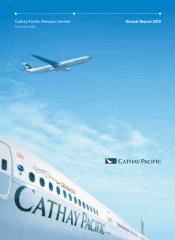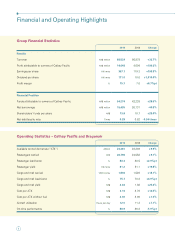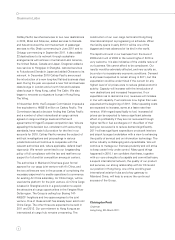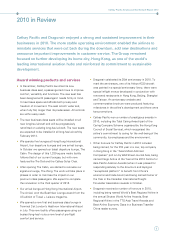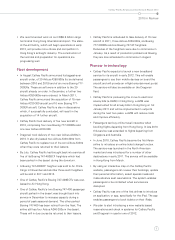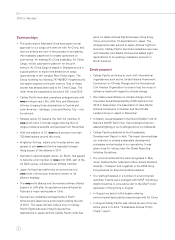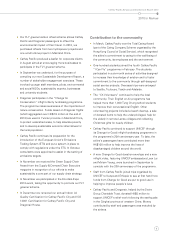Cathay Pacific 2010 Annual Report Download - page 9
Download and view the complete annual report
Please find page 9 of the 2010 Cathay Pacific annual report below. You can navigate through the pages in the report by either clicking on the pages listed below, or by using the keyword search tool below to find specific information within the annual report.
Cathay Pacific Airways Limited Annual Report 2010
7
We recommenced work on our HK$5.5 billion cargo
terminal at Hong Kong International Airport. The state-
of-the-art facility, which will begin operations in early
2013, will provide more choice and competition in
Hong Kong’s airfreight industry. The construction of
the terminal and preparation for operations are
progressing well.
Fleet development
In August Cathay Pacific announced its biggest-ever
aircraft order, of 30 Airbus A350-900s (to be delivered
between 2016 and 2019) and of six more Boeing 777-
300ERs. These aircraft were in addition to the 29
aircraft already on order. In December, a further two
Airbus A350-900s were ordered. In March 2011,
Cathay Pacific announced the acquisition of 15 new
Airbus A330-300 aircraft and 10 new Boeing 777-
300ER aircraft. Cathay Pacific is also in discussions
which, if successfully concluded, will result in the
acquisition of 14 further aircraft.
Cathay Pacific took delivery of five new aircraft in
2010, comprising four new Boeing 777-300ERs and
one new Airbus A330-300.
Dragonair took delivery of two new Airbus A320s in
2010. It also dry-leased two Airbus A330-300s from
Cathay Pacific to replace two of its own Airbus A330s
when they were returned to their lessors.
By July, Cathay Pacific had brought back into service all
five of its Boeing 747-400BCF freighters which had
been parked in the desert during the downturn.
A Boeing 747-400BCF freighter was sold to Air China
Cargo in November and another three such freighters
will be sold in 2011 and 2012.
One of Cathay Pacific’s Boeing 747-400BCFs was wet-
leased to Air Hong Kong.
One of Cathay Pacific’s two Boeing 747-400 passenger
aircraft parked in the desert was brought back into
service in December to increase capacity during a
period of peak seasonal demand. The other parked
Boeing 747-400 has been retired from the fleet. The
airline still has four Airbus A340-300s in the desert.
These will in due course be returned to their lessors.
•
•
•
•
•
•
•
•
Cathay Pacific is scheduled to take delivery of 15 new
aircraft in 2011, three Airbus A330-300s, six Boeing
777-300ERs and six Boeing 747-8F freighters.
Deliveries of the freighters were due to commence in
January. As a result of production problems at Boeing,
they are now scheduled to commence in August.
Pioneer in technology
Cathay Pacific expects to launch a new broadband
service for its aircraft in early 2012. This will enable
passengers to use their mobile devices on board the
aircraft and will provide an inflight entertainment portal.
The service will also be available on the Dragonair
fleet.
Cathay Pacific is pioneering the move to electronic
airway bills (e-AWB) in Hong Kong. e-AWB was
implemented for all airway bills in Hong Kong on 1st
January 2011 and will be implemented in outports
during the next two years. e-AWB will reduce costs
and improve efficiency.
Passengers can buy online travel insurance when
booking flights departing from Hong Kong. In late 2010
this service was extended to flights departing from
Singapore and Australia.
In June 2010, Cathay Pacific became the first Asian
airline to introduce an online ticket change function.
The service was launched in the North American
market and was introduced for a number of other
destinations in early 2011. The service will be available
in Hong Kong from March.
By using an interactive map on the Cathay Pacific
website, passengers can review their bookings, update
their personal information, select special meals and
make advance seat reservations. The system enables
passengers to be contacted when services are
disrupted.
Cathay Pacific was one of the first airlines to introduce
an application, or app, specifically for the iPad. The app
enables passengers to book tickets on their iPads.
We plan to start introducing a new website based
reservations and check in systems for Cathay Pacific
and Dragonair in quarter one of 2012.
•
•
•
•
•
•
•
•
2010 in Review

